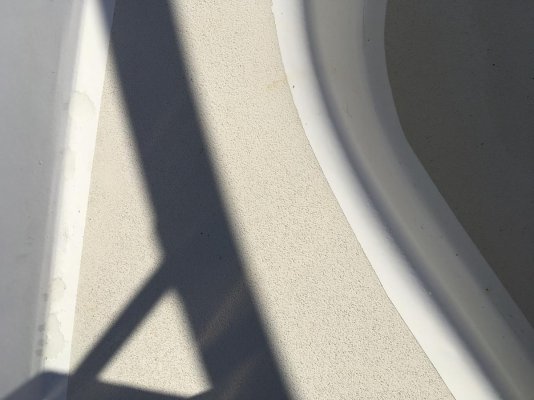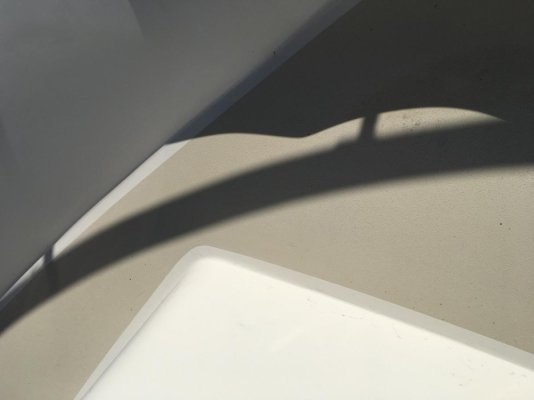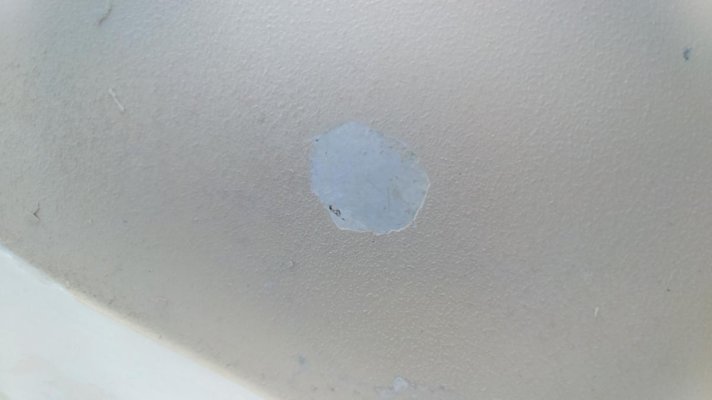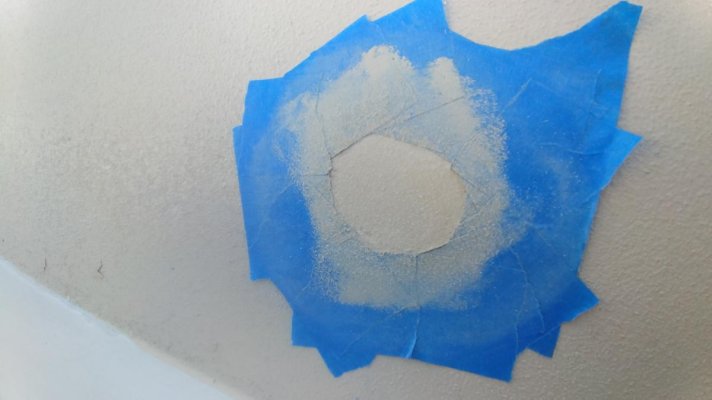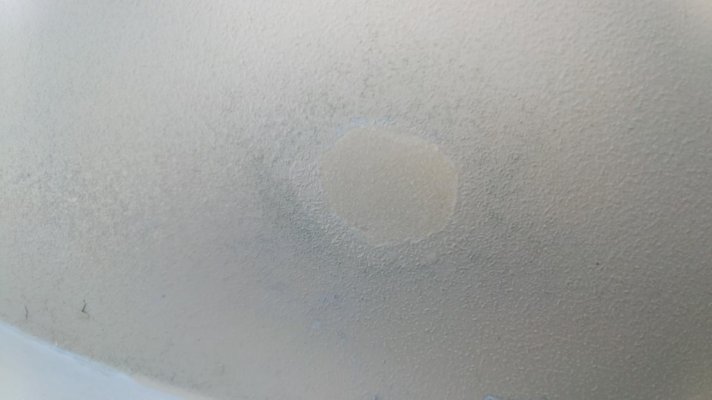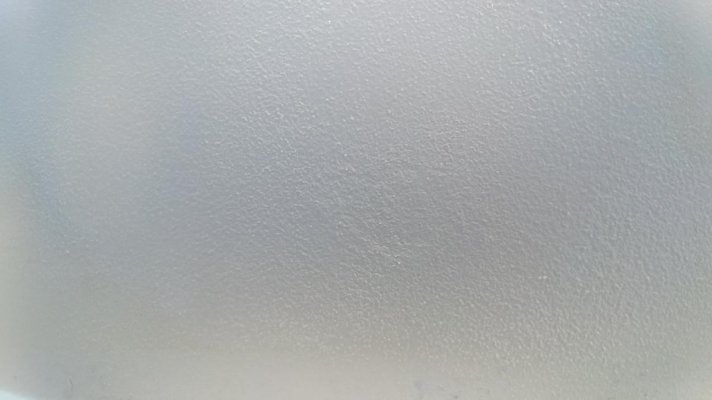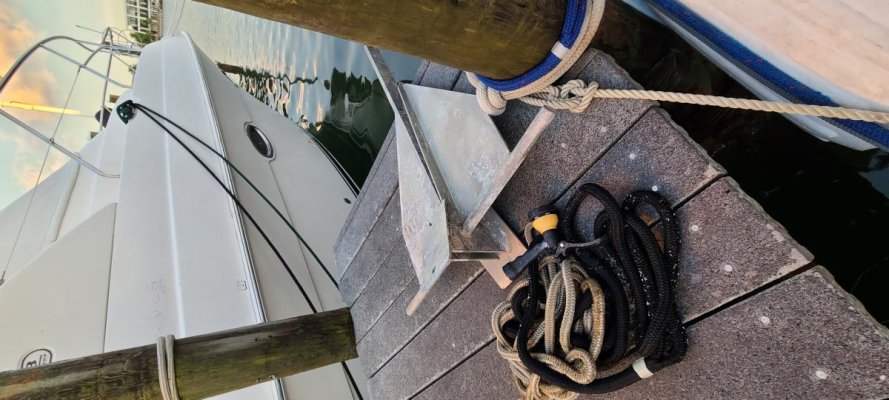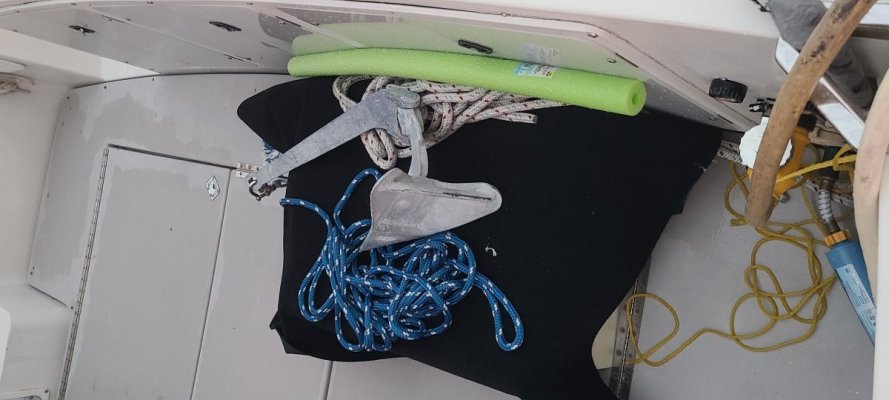STB
Guru
High-density polyurethane foam for deck repair (InjectaDeck)
Hi all,
Quick Ask
Before I post this, may I ask the favor of not turning this thread into a debate or opinion board as to whether I made a good choice or bad one, or whether others should make a similarly good or bad choice?
Instead I would like to share with those who might be interested some facts that I learned, some estimations that I made, and the result to date of my experience, including some photos, answer any questions I can about my experience for others, and see if anyone else has had //actual experience// with the same type of solution I used, good or bad.
I ask this because I chose to repair a section of my front deck using 12-lbs density polyurethane foam branded as InjectaDeck, and in trying to research it on boating forums, there were tons of opinions from those that had never used the material, researched its properties, or even known anyone who had. The boating forums have that type of speculation covered, I think. I'd like this thread to remain based on the properties of the material and/or experience with the material, acknowledging the limitations of my experience which is only now beginning the test of time.
What was in need of repair?
My boat originally had teak decks, including up front. As can happen with teak decks, they reached end-of-life (without major overhaul) and the prior owner removed them, applied an additional sheet or two of glass and some (probably 1-part, but *not* kiwigrip) non-skid paint. The decks were mostly fine, but there was significant softness forward where there were various penetrations for deck hardware, e.g. related to anchoring, and on one side, where I can only imagine an old deck screw or few were leaking. Also, whatever paint was used significantly wore off, even after seemingly less than 2 years.
I contracted a yard to do the repair. My initial proposal was, as I had done on a prior boat, to extensively drill into the deck, dry it out completely, inject tons of epoxy, glass over, and non-skid/paint. The yard didn't feel that the Florida weather would be sufficient to dry the deck thoroughly for that type of repair. Instead, they proposed removing the core in the seemingly soft areas, replacing it with marine plywood, glassing over the repaired areas, fairing, and repainting the deck. I accepted this counter-proposal.
These repairs were completed, but were, in my humble opinion, of low quality and not to spec. They didn't repair all of the soft areas, the patches could be seen as slightly raised areas, the texture was inconsistent, and they ground through the glass overlays in some places while fairing and before painting. Also, instead of using the AwlGrip system, as originally agreed, they used a mix of gelcoat and coarse texture.
I applaud the yard for owning it, recognizing that they didn't do what was agreed, and very promptly giving me a 100%, full, refund -- seemingly unheard of among boatyards! They were nice folks who goofed (perhaps a lot). I don't want to run them through the mud here. I can provide further details in direct messages, if anyone is curious.
During the time that I was able to watch a portion of the original work, I saw that the core being removed wasn't "mush", but wet, and my problem was mostly delamination between the wood and the top fiberglass. For the curious, the core was weaved wood layers.
Preparing for Round II
After further drying the deck from underneath as best as I could over the course of about 8 months, I decided it was time to try again. I was thinking of doing it myself, but as an out-of-town boater who has had a lot of down time doing maintenance recently, I decided I wanted to hire someone, as much as it pained me. My initial thought was to have someone grind the deck down to the fiberglass, fix the problems with the finish work on the recently done patches, do the epoxy injection, and reglass and repaint.
But, I was concerned that, if there was still elevated moisture in there, the epoxy, although it would cure, wouldn't adhere well. And, Florida isn't Southern California, where I did this last time. It is just more wet, more often, in every way.
In thinking about it, I wanted an epoxy like structural resin -- but one that wouldn't just cure when wet, but would also be able to incorporate small amounts of moisture allowing it to bond strongly to slightly moist materials. That brought me to polyurethane, which can bond through moisture by incorporating it, is moisture resistant, and can fill gaps keeping water out in the future.
My initial thought was trying to inject a polyurethane adhesive. But, they all seemed to be either too thick or too rigid when cured. My next thought was a 16lb structural foam from US Composites. It met the requirements above and has great mechanical properties. The challenge was how to inject it.
My next thought was a polyurethane foam and injection system used for foundation repairs. I couldn't find anyone selling those that would sell directly to me and also provide any measure of technical support for the application.
Then, I stumbled into InjectADeck. It seemed to fit the bill, come with an injection system, and be available to an end user. I called the company and spoke to the owner. He filled in some gaps and told me it is a 12-lb polyurethane foam. But, after hearing about my situation, he initially recommended /against/ using it. He felt that, if my core was still solid and the fiberglass was not adhered, it could over expand, push up the fiberglass, and make a mess. None-the-less, he referred me to someone in my area who was experienced with it, Spencer of O'Connell Marine in Palm Harbor near Tarpon Springs, FL.
Spencer came out, and decided it was a good fit. As for over expanding, he felt that wouldn't be a problem as my top fiberglass was solid and they could drill a lot of holes, injecting a little into each, rather than fewer holes, trying to push it father. And, in this way, limit over-expansion and provide plenty of venting preventing push-up. We also agreed that they would drill well past the soft areas to try to inject everywhere they could, so I wouldn't be calling them back when another delaminated area, previously unnoticed, made itself known. They seemed very knowledgeable and like good folks, so I hired them.
Total cost was just under $3,000. It is important to realize that this wasn't just for the repair -- a very significant amount of the cost was grinding off all of the gelcoat and texture applied as part of the prior repair, because I wanted to make sure that work was exposed and repaired as needed. Another cost was actually fixing the problems in those sections, e.g. leveling, fairing, glassing, etc.
A more typical InjectaDeck repair, I am told, would cost far less, because the whole deck doesn't need to be worked and, depending upon the owner's budget, it may not even need to be fully painted vs touch-up painted.
Round II
The repair was done with the boat berthed at Clearwater Municipal Marina. It was done cleanly enough that none of my neighbors nor the marina complained at all. This is impressive because the marina isn't really one that likes major work going on.
The repair took less than 3 days time wise. It was spread out over about 5 days, due to their schedule and me not caring as I wasn't around at the time.
A bunch of pictures of the InjectADeck portion of the repair and the final result can be found here:
-- https://drive.google.com/drive/folders/1PmduxDyL6BMa4Ax4uPQ3NfPZDzRI0oI5?usp=sharing
I haven't yet been to the boat since it was done, but it was inspected by people I trust, and I am told it looks perfect and feels solid. I'm going to sound it with a hammer in a couple of weeks when I'm there. But, I 100% trust the folks who checked on it.
For $3,000 Why didn't I just replace the deck core?
My goal wasn't to save money. It was to definitively solve the problem while preserving boating time.
I did save some money as compared to a full re-decking, I don't know how much. If I had to hazard a guess, I'd guess replacing the decking would have been ~$5,000, meaning I saved about $2,000. But, that wasn't the motivating factor.
I am convinced that polyurethane has the ability to solve the problem I was having with the bonding of the fiberglass to the wood, and convinced that it could do that even with whatever moisture might be remaining, which I am not entirely confident epoxy could have done (though maybe). I also felt that the expanding foam, although less dense and with less compressive strength than (less foaming) polyurethane adhesives still had the compressive strength that was needed, and could also fill any small voids to minimize the impact of any water that might leak in.
I might have felt differently if my decks were really mushy. But, my sense is that with mostly good core and mostly small problems, what I really needed was good adhesive coverage and good bonding.
It is also the case that I haven't been really sold on some of the redecking projects I've seen. They've cut the glass off the deck, replaced the core, epoxied it back down, glass taped over the seams, faired and repainted. And, that's all good. But in some cases the plywood has been pieced in, looked like a jigsaw puzzle, had some large gaps filled with resin, and I just haven't been convinced it was been as good as the original. I've walked across some decks that had been replaced a few years after it was done and felt movement or seen cracks in the paint forming. Without me being there, I just didn't feel I could quality control for that at all.
What is InjectaDeck and what are its properties?
It is a 12-lb density polyurethane foam that I think is more broadly marketed by at least another company for gap-filling in foundation repairs.
Polyurethane foam can incorporate (small amounts of) water while curing, so within some reason, it can bond despite the substrate being wet. This was an important property to me. And, the reason I chose it over an epoxy.
The properties reported to me by InjectaDeck were as follows:
Density (Core) Free Rise 12 Lbs Astm D 1622
Low Temperature Astm D 2126
Aging ( 20F) (Shrinkage) <0% 1 Day
(Shrinkage) <0% 7 Days
Water Absorption <1% Astm D 2127
(Volume Confined)
Shear Strength 75Psi Astm C 273
Tensile Strength 300 Psi Astm D 1623
Elongation 5% Astm D 1623
Viscosity 375 Cps
% Solid 100
Color Amber
Tdi Content 0%
Usdot Shipping Data Unregulated Class 55
One critical measure missing was the compressive strength. I called those I believe to be the original supplier to InjectaDeck, and they didn't have this number available. But, they "total wild guessed" it to be in the "300-450psi" ballpark. By comparing its properties to similar materials sold by other distributors, this seems very consistent to what I'd also guess.
Using the low number of 300psi, the material seems well suited for the intended purpose.
Who supplies the material to InjectaDeck?
The InjectaDeck folks were extremely helpful to me with the technical specs, so much so that I was able to track it back to what I think is the actual supplier to them. But, I'm not going to post their name as to not undercut InjectaDeck. I don't want to punish them for providing me with the technical details in full. It was good to see them not playing "hide the ball".
And, in my opinion, whatever their mark-up, they were 100% worth it to me. They took my phone calls, text messages, and emails. They answered every question. They earned their money through added value.
My view is that, for this application, one should buy it from them -- and save the foundation distributors for foundations.
If you really, really, really want the name of the supplier I found, DM me. I'll give it to you. But, I don't recommend that. It'll just cause the folks we need to support us to support us less.
My Assessment To Date
Epoxies are much stronger/tougher in essentially every way. But, in my own assessment, for my situation, what reality mattered was the ability to adhere to glass and wood given the moisture that in reality exists in almost any deck. I'm better off with a well-bonded polyurethane than an epoxy that won't necessarily bond well in the real world situation, I think. And, my decks just weren't ripe for replacement, and I didn't want to wait for them to get there.
I probably would have felt differently if I had mushy decks. But, for what they charge for InjectaDeck, I'd might also recommend that someone trying to balance boating time or money with longevity dry a deck out as best as possible and give it a shot. It is pretty inexpensive. There isn't much to be lost. I like to do things Right, but I also don't like to make the Imaginary Perfect become the Enemy of the Real World Good or falling into the trap that repair needs to wait until it makes sense to replace with new.
I don't think one can expect to shoot it in between two layers of glass with wood mud inside and expect anything good to come of it. It isn't a magic bullet. But, I really do think that there is a useful place for it in situations like mine that aren't bad, but are also show their age in places.
The Future?
If the deck shows any signs of failure or degradation in the future, I'll try to remember to post here. I may or may not remember to update it in a few years if it is still good. But, if anyone ever wants to ask how it is lasting, reply here or DM me.
Hi all,
Quick Ask
Before I post this, may I ask the favor of not turning this thread into a debate or opinion board as to whether I made a good choice or bad one, or whether others should make a similarly good or bad choice?
Instead I would like to share with those who might be interested some facts that I learned, some estimations that I made, and the result to date of my experience, including some photos, answer any questions I can about my experience for others, and see if anyone else has had //actual experience// with the same type of solution I used, good or bad.
I ask this because I chose to repair a section of my front deck using 12-lbs density polyurethane foam branded as InjectaDeck, and in trying to research it on boating forums, there were tons of opinions from those that had never used the material, researched its properties, or even known anyone who had. The boating forums have that type of speculation covered, I think. I'd like this thread to remain based on the properties of the material and/or experience with the material, acknowledging the limitations of my experience which is only now beginning the test of time.
What was in need of repair?
My boat originally had teak decks, including up front. As can happen with teak decks, they reached end-of-life (without major overhaul) and the prior owner removed them, applied an additional sheet or two of glass and some (probably 1-part, but *not* kiwigrip) non-skid paint. The decks were mostly fine, but there was significant softness forward where there were various penetrations for deck hardware, e.g. related to anchoring, and on one side, where I can only imagine an old deck screw or few were leaking. Also, whatever paint was used significantly wore off, even after seemingly less than 2 years.
I contracted a yard to do the repair. My initial proposal was, as I had done on a prior boat, to extensively drill into the deck, dry it out completely, inject tons of epoxy, glass over, and non-skid/paint. The yard didn't feel that the Florida weather would be sufficient to dry the deck thoroughly for that type of repair. Instead, they proposed removing the core in the seemingly soft areas, replacing it with marine plywood, glassing over the repaired areas, fairing, and repainting the deck. I accepted this counter-proposal.
These repairs were completed, but were, in my humble opinion, of low quality and not to spec. They didn't repair all of the soft areas, the patches could be seen as slightly raised areas, the texture was inconsistent, and they ground through the glass overlays in some places while fairing and before painting. Also, instead of using the AwlGrip system, as originally agreed, they used a mix of gelcoat and coarse texture.
I applaud the yard for owning it, recognizing that they didn't do what was agreed, and very promptly giving me a 100%, full, refund -- seemingly unheard of among boatyards! They were nice folks who goofed (perhaps a lot). I don't want to run them through the mud here. I can provide further details in direct messages, if anyone is curious.
During the time that I was able to watch a portion of the original work, I saw that the core being removed wasn't "mush", but wet, and my problem was mostly delamination between the wood and the top fiberglass. For the curious, the core was weaved wood layers.
Preparing for Round II
After further drying the deck from underneath as best as I could over the course of about 8 months, I decided it was time to try again. I was thinking of doing it myself, but as an out-of-town boater who has had a lot of down time doing maintenance recently, I decided I wanted to hire someone, as much as it pained me. My initial thought was to have someone grind the deck down to the fiberglass, fix the problems with the finish work on the recently done patches, do the epoxy injection, and reglass and repaint.
But, I was concerned that, if there was still elevated moisture in there, the epoxy, although it would cure, wouldn't adhere well. And, Florida isn't Southern California, where I did this last time. It is just more wet, more often, in every way.
In thinking about it, I wanted an epoxy like structural resin -- but one that wouldn't just cure when wet, but would also be able to incorporate small amounts of moisture allowing it to bond strongly to slightly moist materials. That brought me to polyurethane, which can bond through moisture by incorporating it, is moisture resistant, and can fill gaps keeping water out in the future.
My initial thought was trying to inject a polyurethane adhesive. But, they all seemed to be either too thick or too rigid when cured. My next thought was a 16lb structural foam from US Composites. It met the requirements above and has great mechanical properties. The challenge was how to inject it.
My next thought was a polyurethane foam and injection system used for foundation repairs. I couldn't find anyone selling those that would sell directly to me and also provide any measure of technical support for the application.
Then, I stumbled into InjectADeck. It seemed to fit the bill, come with an injection system, and be available to an end user. I called the company and spoke to the owner. He filled in some gaps and told me it is a 12-lb polyurethane foam. But, after hearing about my situation, he initially recommended /against/ using it. He felt that, if my core was still solid and the fiberglass was not adhered, it could over expand, push up the fiberglass, and make a mess. None-the-less, he referred me to someone in my area who was experienced with it, Spencer of O'Connell Marine in Palm Harbor near Tarpon Springs, FL.
Spencer came out, and decided it was a good fit. As for over expanding, he felt that wouldn't be a problem as my top fiberglass was solid and they could drill a lot of holes, injecting a little into each, rather than fewer holes, trying to push it father. And, in this way, limit over-expansion and provide plenty of venting preventing push-up. We also agreed that they would drill well past the soft areas to try to inject everywhere they could, so I wouldn't be calling them back when another delaminated area, previously unnoticed, made itself known. They seemed very knowledgeable and like good folks, so I hired them.
Total cost was just under $3,000. It is important to realize that this wasn't just for the repair -- a very significant amount of the cost was grinding off all of the gelcoat and texture applied as part of the prior repair, because I wanted to make sure that work was exposed and repaired as needed. Another cost was actually fixing the problems in those sections, e.g. leveling, fairing, glassing, etc.
A more typical InjectaDeck repair, I am told, would cost far less, because the whole deck doesn't need to be worked and, depending upon the owner's budget, it may not even need to be fully painted vs touch-up painted.
Round II
The repair was done with the boat berthed at Clearwater Municipal Marina. It was done cleanly enough that none of my neighbors nor the marina complained at all. This is impressive because the marina isn't really one that likes major work going on.
The repair took less than 3 days time wise. It was spread out over about 5 days, due to their schedule and me not caring as I wasn't around at the time.
A bunch of pictures of the InjectADeck portion of the repair and the final result can be found here:
-- https://drive.google.com/drive/folders/1PmduxDyL6BMa4Ax4uPQ3NfPZDzRI0oI5?usp=sharing
I haven't yet been to the boat since it was done, but it was inspected by people I trust, and I am told it looks perfect and feels solid. I'm going to sound it with a hammer in a couple of weeks when I'm there. But, I 100% trust the folks who checked on it.
For $3,000 Why didn't I just replace the deck core?
My goal wasn't to save money. It was to definitively solve the problem while preserving boating time.
I did save some money as compared to a full re-decking, I don't know how much. If I had to hazard a guess, I'd guess replacing the decking would have been ~$5,000, meaning I saved about $2,000. But, that wasn't the motivating factor.
I am convinced that polyurethane has the ability to solve the problem I was having with the bonding of the fiberglass to the wood, and convinced that it could do that even with whatever moisture might be remaining, which I am not entirely confident epoxy could have done (though maybe). I also felt that the expanding foam, although less dense and with less compressive strength than (less foaming) polyurethane adhesives still had the compressive strength that was needed, and could also fill any small voids to minimize the impact of any water that might leak in.
I might have felt differently if my decks were really mushy. But, my sense is that with mostly good core and mostly small problems, what I really needed was good adhesive coverage and good bonding.
It is also the case that I haven't been really sold on some of the redecking projects I've seen. They've cut the glass off the deck, replaced the core, epoxied it back down, glass taped over the seams, faired and repainted. And, that's all good. But in some cases the plywood has been pieced in, looked like a jigsaw puzzle, had some large gaps filled with resin, and I just haven't been convinced it was been as good as the original. I've walked across some decks that had been replaced a few years after it was done and felt movement or seen cracks in the paint forming. Without me being there, I just didn't feel I could quality control for that at all.
What is InjectaDeck and what are its properties?
It is a 12-lb density polyurethane foam that I think is more broadly marketed by at least another company for gap-filling in foundation repairs.
Polyurethane foam can incorporate (small amounts of) water while curing, so within some reason, it can bond despite the substrate being wet. This was an important property to me. And, the reason I chose it over an epoxy.
The properties reported to me by InjectaDeck were as follows:
Density (Core) Free Rise 12 Lbs Astm D 1622
Low Temperature Astm D 2126
Aging ( 20F) (Shrinkage) <0% 1 Day
(Shrinkage) <0% 7 Days
Water Absorption <1% Astm D 2127
(Volume Confined)
Shear Strength 75Psi Astm C 273
Tensile Strength 300 Psi Astm D 1623
Elongation 5% Astm D 1623
Viscosity 375 Cps
% Solid 100
Color Amber
Tdi Content 0%
Usdot Shipping Data Unregulated Class 55
One critical measure missing was the compressive strength. I called those I believe to be the original supplier to InjectaDeck, and they didn't have this number available. But, they "total wild guessed" it to be in the "300-450psi" ballpark. By comparing its properties to similar materials sold by other distributors, this seems very consistent to what I'd also guess.
Using the low number of 300psi, the material seems well suited for the intended purpose.
Who supplies the material to InjectaDeck?
The InjectaDeck folks were extremely helpful to me with the technical specs, so much so that I was able to track it back to what I think is the actual supplier to them. But, I'm not going to post their name as to not undercut InjectaDeck. I don't want to punish them for providing me with the technical details in full. It was good to see them not playing "hide the ball".
And, in my opinion, whatever their mark-up, they were 100% worth it to me. They took my phone calls, text messages, and emails. They answered every question. They earned their money through added value.
My view is that, for this application, one should buy it from them -- and save the foundation distributors for foundations.
If you really, really, really want the name of the supplier I found, DM me. I'll give it to you. But, I don't recommend that. It'll just cause the folks we need to support us to support us less.
My Assessment To Date
Epoxies are much stronger/tougher in essentially every way. But, in my own assessment, for my situation, what reality mattered was the ability to adhere to glass and wood given the moisture that in reality exists in almost any deck. I'm better off with a well-bonded polyurethane than an epoxy that won't necessarily bond well in the real world situation, I think. And, my decks just weren't ripe for replacement, and I didn't want to wait for them to get there.
I probably would have felt differently if I had mushy decks. But, for what they charge for InjectaDeck, I'd might also recommend that someone trying to balance boating time or money with longevity dry a deck out as best as possible and give it a shot. It is pretty inexpensive. There isn't much to be lost. I like to do things Right, but I also don't like to make the Imaginary Perfect become the Enemy of the Real World Good or falling into the trap that repair needs to wait until it makes sense to replace with new.
I don't think one can expect to shoot it in between two layers of glass with wood mud inside and expect anything good to come of it. It isn't a magic bullet. But, I really do think that there is a useful place for it in situations like mine that aren't bad, but are also show their age in places.
The Future?
If the deck shows any signs of failure or degradation in the future, I'll try to remember to post here. I may or may not remember to update it in a few years if it is still good. But, if anyone ever wants to ask how it is lasting, reply here or DM me.
Last edited:


